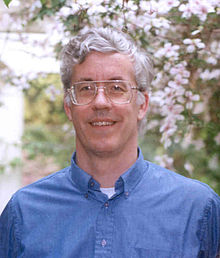William E. Caswell
| William E. Caswell | |
|---|---|
 |
|
| Born |
William Edward Caswell June 22, 1947 Boston, Massachusetts, United States |
| Status | Married (until death) |
| Died | September 11, 2001 (aged 54) Arlington County, Virginia, United States |
| Cause of death | Plane crash |
| Nationality | American |
| Children | 1 |
William Edward Caswell (June 22, 1947 – September 11, 2001) was a physicist who died during the September 11 attacks, as a passenger aboard American Airlines Flight 77, which was crashed into the Pentagon. Caswell did work in quantum gauge theory, most notably, his 1972 calculation of the beta function to two-loop accuracy. His pioneering work in the days of FORTRAN and punch cards demonstrated the potential of computer algebra.
William Edward Caswell was born on June 22, 1947 in Boston, Massachusetts, the eldest of six children. He lived most of his life in Silver Spring, Maryland.
In high school he became a scholar. He attended the University of Maryland and graduated Phi Beta Kappa in three years. He then attended graduate school at Princeton University, majoring in physics. His work at Princeton was delayed when he was drafted into the Army during the Vietnam War, where he came to admire the drill sergeant to whom he was assigned for basic training. When Caswell resumed his studies at Princeton, he chose to work in elementary particle theory. He received his Ph.D. in Physics in January 1975, and subsequently did postdoctoral work at Stanford University and Brown University.
With his thesis advisor Curtis Callan, Caswell embarked on an ambitious program for the summation of Feynman loops in order to calculate elementary particle properties. His thesis, published in 1974, was groundbreaking work that encouraged and shaped future research. To quote his obituary in Physics Today: "Today the interpretation of many experiments in high-energy physics requires multiloop quantum chromodynamics calculations, and Bill's result is a prime ingredient in every such calculation. It is also a critical ingredient in calculating the running of the coupling constants of the Standard Model's supersymmetric extensions, calculations that are interpreted these days as evidence for both grand unification and low-energy supersymmetry. Thus Bill's work is also crucial to our thinking about physics beyond the Standard Model."
...
Wikipedia
